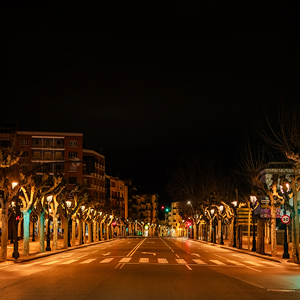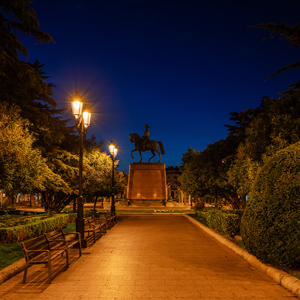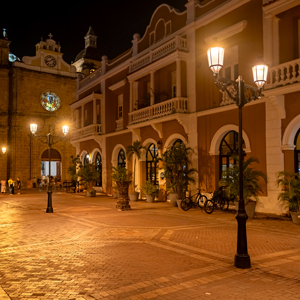A well-distributed light can completely transform how we perceive public space. This third Campus ATP article explores lighting uniformity and its impact on safety, energy efficiency, and visual comfort.
ARRE —16/5/2025— When assessing the quality of an outdoor lighting project, most attention is usually paid to the lighting level: how much light is there, is it enough, does it meet the standards. But there's another, more subtle factor that is often overlooked—and yet it can make the difference between an efficient installation and a poor one: lighting uniformity.
More light doesn’t always mean better light
Lighting uniformity refers to how evenly light is distributed across a surface. The higher the uniformity, the smaller the difference between the brightest and darkest areas: there are no patches of shadow or excessively bright spots—just a continuous, balanced lighting experience. In practical terms, it determines whether a street appears evenly lit or full of dark spots next to glaring areas.
Technically, it is expressed as a value between 0 and 1, where 1 means perfect distribution (the entire surface receives the same illumination) and 0 means no uniformity at all. There are several ways to calculate it, with the most common being:
General uniformity (Uo) = minimum illuminance / average illuminance
Longitudinal uniformity (Ul) = minimum illuminance / maximum illuminance (especially relevant for roadways)
A good level of uniformity—typically between 0.6 and 0.8 in well-designed projects—improves visual perception, reduces eye strain, and can even allow for lower lighting levels without compromising visibility.
The “zebra effect” problema
An installation may offer high lighting levels but still deliver a poor visual experience if the distribution is irregular. This is what’s known as the “zebra effect”: alternating strips of bright and dark areas that make it hard to perceive space comfortably. This pattern causes visual fatigue, hinders depth perception, and can pose risks for both pedestrians and drivers.
On the other hand, a system with lower lighting levels but high uniformity can be far more effective—ensuring comfort, reducing energy use, and minimizing light pollution.
How is good uniformity achieved?
It all starts with a well-designed lighting layout and the adaptability of the selected luminaires. There are no one-size-fits-all solutions: every location requires a tailored approach. Street geometry, mounting height, surrounding vegetation or architectural heritage—all these factors must be considered.
This is where versatile luminaires and precision technology make the difference. At ATP, each project is developed using custom optics and photometric specification manufacturing, allowing us to direct light exactly where it’s needed with pinpoint accuracy.
Logroño: precise lighting in a historic city center
In the historic center of Logroño, the municipality replaced nearly 900 luminaires with ATP’s 2200 K LED models, achieving uniformity values of up to 0.8 with minimal power levels (19 to 35 W). Thanks to a detailed lighting study and made-to-measure manufacturing, the result is a soft, continuous illumination that blends seamlessly with the city’s architectural character.
This approach has improved visibility and cut energy consumption by more than 70 %, without the need for overlighting. Additionally, the luminaires’ low spectral blue content (1.28 %) helps protect the night sky and reduce disruption to human and animal circadian rhythms.
Cartagena de Indias: uniformity in a Caribbean heritage site
In Cartagena’s UNESCO-listed Ciudad Amurallada, outdated discharge lamps were replaced with ATP LED luminaires at a warm 2200 K and fitted with Comfort Diffuser®. The result: dark areas were eliminated, lighting became more uniform, and the night-time perception of the space was transformed—boosting tourism and social activity.
Thanks to meticulous planning and corrosion-proof materials, the new system is safer, more attractive, and more sustainable, with over 70 % energy savings and a dramatic reduction in light pollution.
Zaragoza: efficiency and visual warmth
In Zaragoza, public lighting was upgraded in both the Pignatelli district and the Parque del Agua, using ATP LED luminaires at 2200 K and 1800 K, paired with high-precision optics. These achieved uniformities of up to 0.9, eliminated glare, and helped preserve the night sky. The Comfort Diffuser® was key in creating a soft and balanced light.
The result: the park is now a national benchmark for sustainable lighting in natural spaces, proving that it’s onfort to combine visual onfort, energy savings, and environmental care—even in complex urban settings.
Uniformity as an ally in reducing light pollution
Lowering lighting levels without sacrificing visibility is possible when effective design meets precision technology. In fact, much of the light pollution we see doesn’t come directly from luminaires—it’s the reflected light bouncing off the ground and scattering into the atmosphere. A uniform, optimized design greatly reduces this effect.
The takeaway is clear: good lighting isn’t about using more light, but using it better. And that begins with understanding the importance of well-distributed illumination.
Press contact:
Julio Aparicio
ATP Lighting
comunicacion@atpiluminacion.com
Copyright © 2016 ATP Lighting Inc. All rights reserved. ATP Lighting, the ATP Lighting logo and all trade names listed on this website with the ® symbol are registered trademarks of ATP Lighting.









![[...]](https://www.atpiluminacion.com/xtra/imgs/loading.gif)